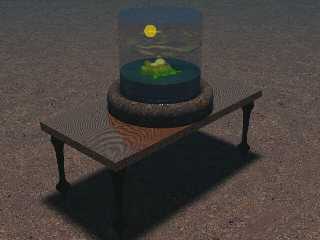|
 |
Neonux wrote:
>Not sure if this fits this category... but its just something that came to
>me.
>
>I'm not too happy with the clouds or sun yet but it gives an indication
>anyway... :)
>
>NeoNux
>
It fits the style, certainly, but you're definitely right about the clouds
and
sun needing work, and from an artistic pov I think it's lacking a focus. It
might
have more impact if the container was a fishbowl/fishtank, or a computer
monitor
(although that idea has been done in irtc before...).
'course it's hard to be too objective or constructive when I'm working on my
own
entry, but I'm trying. ;)
--Chris
Post a reply to this message
|
 |
|
 |
> It fits the style, certainly, but you're definitely right about the clouds
> and sun needing work.
OK I'm a little happier with the clouds in this one... but its a long way
off..
I've been messing around with the sun for ages and just can't get anything
I'm happy with at all... <sigh>
Never mind. If anyone know a good method... ?
> It might have more impact if the container was a fishbowl/fishtank,
> or a computer monitor
> (although that idea has been done in irtc before...).
Exactly why I didn't want to go down that road.
Post a reply to this message
Attachments:
Download 'surreal2.jpg' (56 KB)
Preview of image 'surreal2.jpg'

|
 |
|
 |
Well, asking for suggestions, here are mine:
There are two methods simulating clouds with POV-Ray:
1. Stacked-Planes
2. Media
Since POV-Ray 3.5, media has become efficient enough
to render clouds in a reasonable time with reasonable
quality. So, I suggest using scattering media 3, with high
enough scattering and additionally, high enough absorption.
I mostly do something like:
media{
scattering{3, Some_Color} absorption <1,1,1>-Some_Color
method 3 intervals 1 samples Low_Samples, High_Samples
density{rgb Some_Dense_Value}
density{ some_Pattern }
}
Where Color is the color of the clouds, low- and high-samples
is used for calculating the media. I'd stick to values like
25,50 at the beginning and increase as needed.
The solid density is used to multiply the scattering, this could also
be achieved by simply multiplying the values for scattering
and absorption (for absorption, do like
(<1,1,1>-Some_Color)*Multiplier)
I just prefer using a solid density to control that, there's no actual
difference anyway.
For the sun, a media with spherical pattern to give a soft glow,
colors are of your choosing (after all, its your image, you should
come up with most of it :-)
As an advice: don't look at my website until you've finished the
image. I've done something similiar and don't want to spoil you
the fun of doing this and being creative about it. Additionally,
it seems that I've got a little more experience, so if you'd see
my image, you might lose interest in finishing yours. I don't want
that to happen: after all, there are a lot of people out here who
might come up with similiar ideas. That doesn't make yours
less original.
Regards,
Tim
--
Tim Nikias v2.0
Homepage: http://www.digitaltwilight.de/no_lights
> Not sure if this fits this category... but its just something that came to
> me.
>
> I'm not too happy with the clouds or sun yet but it gives an indication
> anyway... :)
>
> NeoNux
>
>
>
>
---
Outgoing mail is certified Virus Free.
Checked by AVG anti-virus system (http://www.grisoft.com).
Version: 6.0.495 / Virus Database: 294 - Release Date: 30.06.2003
Post a reply to this message
|
 |
|
 |
Hi :-)
This one is better.
You'd better rotate the table top pattern along its length as wood pieces
are usually cut.
BTW the pattern is unevenly scaled (elliptic) did you model the scene in
Moray?
If yes don't forget that Moray boxes are box{-1,1} scaled after texture is
attributed, so when you resize it you resize texture (unless you select
world or parent in material options)
A workaround is to set box size in local coordinates so it is done before
attributing texture.
CU
Marc
Post a reply to this message
|
 |




![]()